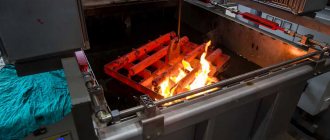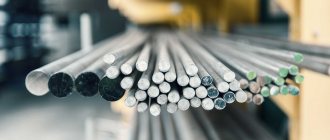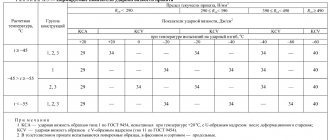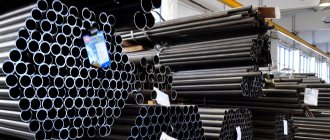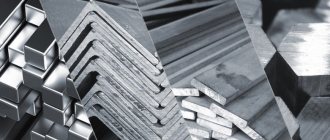The figure below shows eight typical states of industrial steel ingots that have been cast into identical, tapered molds. They are arranged and numbered according to the degree of suppression of gas emission during solidification. The dashed lines indicate the level to which the steel was initially poured in each mold. Depending on the carbon content, and even more so on the oxygen content, the structure of the ingots varies. Number 1 is completely calmed steel, calmed steel
, and number 8 - steel to which deoxidation operations were not applied, highly
boiling steel
.
Figure - Eight typical states of industrial steel ingots with varying degrees of deoxidation
When cast into ingots, steels are classified into three main types depending on the degree of deoxidation or, which is the same, according to the amount of gases released during the solidification of the ingot.
These four types include: - mild steel; - semi-quiet steel
; - boiling steel.
Calm steel
In English, calm steel is called slightly “intimidating” - killed
steel
. Calm steel is steel in which there is virtually no gas emission when the ingot solidifies after casting. This is ensured by complete deoxidation of the steel - complete removal of oxygen from it and the formation of a shrinkage cavity in the upper part of the ingot. This part of the ingot is then cut off and scrapped.
All alloy steels, most low alloy steels and many carbon steels are commonly used as mild steels. During continuous casting, the steel is also “calmed” completely. Calm steel is characterized by a homogeneous structure and uniform distribution of chemical composition and properties.
To obtain mild steel, it is deoxidized with aluminum, as well as manganese or silicon ferroalloys. In addition, calcium silicide and other special deoxidizers are sometimes used.
Semi-quiet steel
In semi-quiet steel, the release of gases during its deoxidation is not completely suppressed, since the steel is only partially deoxidized. In English it is called semikilled
steel
. The degree of gas evolution in these steels is greater than in calm steels, but less than in boiling steels. Before the release of gases begins, a crust of considerable thickness forms in the ingot. A properly “semi-deoxidized” steel ingot does not have a shrinkage cavity, but there are bubbles widely dispersed throughout the thickness in the central zone of the upper part of the ingot. These bubbles, however, are sealed when the ingot is rolled. Semi-quiet steels typically have a carbon content of 0.15 to 0.30%. They are widely used in the production of long products, strips and pipes.
The main differences between semi-quiet steels are: 1) different degrees of heterogeneity of the chemical composition - average between the degrees of calm and boiling steels; 2) less segregation of chemical elements than in plain steel; 3) a pronounced tendency for positive chemical segregation in the center of the upper part of the ingot (figure).
Boiling steel
Boiling steel is characterized by: - a high degree of gas evolution during the solidification of steel in the mold; — a noticeable difference in the chemical composition across the cross section of the ingot and between the upper and lower parts of the ingot (see figure).
This leads to the formation of relatively pure iron in the outer shell of the ingot and the inner core of the ingot with a high concentration of alloying and impurity elements, especially carbon, nitrogen, sulfur and phosphorus, which have a low melting point. The cleaner outer part of the ingot is used during rolling. Boiling steel ingots are well suited for the production of many products such as plates, sheets, wire, pipes, as well as long products with requirements for surface cleanliness and toughness properties.
The technology for producing boiling steels is limited by the maximum content of carbon and manganese. This steel does not contain any noticeable amounts of strong deoxidizing agents such as aluminum, silicon or titanium. Boiling steel is cheaper than calm and semi-calm steel, since only a small amount of deoxidizer is used for it, and the upper part of the ingot is not scrapped.
What types of carbon steel are there according to the degree of deoxidation?
The classification of this alloy is based on various parameters, one of which is the degree of deoxidation. Any method of steel production is accompanied by a continuous increase in oxygen, the amount of which depends primarily on the concentration of carbon. To avoid the harmful effects of oxygen on the metal, a deoxidation procedure is carried out. Taking this parameter into account, carbon steel is divided into:
- Calm - such alloys are characterized by a more uniform, homogeneous structure. Deoxidation is carried out using substances free of ferrous oxides (for example, aluminum). Due to the residual aluminum, grain growth is stopped, due to which the steel obtains a fine-grained structure. The result is a high-quality material, completely free of gases, from which high-strength, wear-resistant parts and structures can be produced. The disadvantages of mild steels include the high cost of their smelting.
- Boiling - this type is characterized by cheaper production, since a minimum of deoxidizing agents are used during smelting. The internal structure of such steel contains a large amount of dissolved gases - one of the reasons for the decrease in the quality of the metal. For example, the presence of nitrogen interferes with normal welding of carbon steel (many cracks appear in the area of the weld). Due to the developed segregation in boiling alloys, rolled products with a heterogeneous structure and unstable mechanical properties are produced.
- Semi-calm - before pouring, the composition is enriched with a small amount of deoxidizing agents. After this, the metal hardens without boiling, but gases continue to be released in it. In a casting made of semi-quiet steel, gas bubbles are contained in smaller quantities, and subsequent rolling of the metal allows you to almost completely get rid of micropores.
"Clogged" steel
In English, boiling steel is usually rimmed
steel
.
From the English word rim - rim, frame, bandage. This term reflects the main feature of a boiling steel ingot - the outer shell (frame, rim, bandage) of pure steel. English-language technical literature describes another type of boiling steel - capped steel .
C apped
steel is
a type of steel with characteristics similar to boiling steel, but in terms of the degree of suppression of gas evolution during solidification, it is located between semi-quiet and boiling steel (see figure).
The name of this type of steel comes from the English word cap
in the Russian meaning “lid”, so these ingots after casting are mechanically or chemically closed, “clogged” from above. So their Russian term might be “clogged steels.”
To produce “clogged” steel ingots, less deoxidizing agents are used than for semi-blank ingots. This makes it possible to control, to a certain extent, the formation of the outer layer of the ingot during its solidification.
The ingot sealing technology is a variation of the boiling steel production technology. The act of sealing the ingot limits the time for gases to be released and prevents the formation of excessive gas bubbles within the ingot. Capped ingots are typically used for steels with a carbon content greater than 0.15%, from which sheets, strips, thin plates, strips, wires and rods are produced.
When mechanically sealing steel ingots, heavy cast iron caps are used to seal the mold at the top and stop the formation of an outer shell, as occurs with boiling ingots. Chemical sealing of ingots is carried out in open molds. Capping is accomplished by adding aluminum or ferrosilicon to the top of the mold, causing the top surface of the ingot to rapidly solidify. The top part of the ingot is then cut off and sent to scrap.
Source: steel-guide.ru
Degree of deoxidation.
According to the degree of deoxidation* there are:
· calm steels - steels deoxidized by Mn; Al; Si;
· boiling steels - steels deoxidized by Mn;
· semi-quiet steels - steels deoxidized by Mn; Al.
* Deoxidation is the reduction of an element from its oxides. Deoxidizers are elements that reduce another element from its oxides.
Method for producing products from steel.
According to the method of producing steel products, they are distinguished:
§ deformable steels (products are manufactured by pressure treatment);
- foundry steels (products are manufactured by casting).
Terms of delivery to consumers.
Ordinary quality steel is further divided into 3 groups according to delivery conditions:
group A steel - supplied to consumers based on mechanical properties (such steel may have a high sulfur or phosphorus content);
· group B steel - by chemical composition;
· Group B - with guaranteed mechanical properties and chemical composition.
Steel marking
Calm steels are marked with the letters “sp” (sometimes the letters are omitted);
Boiling steels are marked with the letters “kp”;
Semi-quiet steels are marked with the letters “ps”.
Classification and marking of steels - Lazar59
Steels are usually called alloys of iron and carbon containing up to 2.14% carbon. Depending on the chemical composition, carbon steels (GOST 380-71, GOST 1050-75) and alloy steels (GOST 4543-71, GOST 5632-72, GOST 14959-79) are distinguished.
In turn, carbon steels can be:
- low-carbon, i.e. containing less than 0.25% carbon;
- medium-carbon, carbon content is 0.25-0.60%;
- high-carbon, in which the carbon concentration exceeds 0.60%.
Alloy steels are divided into:
| Table of elementsMS Word, 40Kb |
- low alloy content of alloying elements up to 2.5%;
- medium alloyed, they contain from 2.5 to 10% alloying elements;
- highly alloyed, which contain over 10% alloying elements.
Purpose
Structural, intended for the manufacture of construction and engineering products.
Tools, from which cutting, measuring, stamping and other tools are made. These steels contain more than 0.65% carbon.
With special physical properties, for example, with certain magnetic characteristics or a low coefficient of linear expansion: electrical steel, superinvar.
With special chemical properties, for example stainless, heat-resistant or heat-resistant steels.
Quality
Depending on the content of harmful impurities: sulfur and phosphorus, steel is divided into:
- Steel of ordinary quality, content up to 0.06% sulfur and up to 0.07% phosphorus.
- High-quality - up to 0.035% sulfur and phosphorus each separately.
- High quality - up to 0.025% sulfur and phosphorus.
- Particularly high quality, up to 0.025% phosphorus and up to 0.015% sulfur.
Degree of deoxidation
According to the degree of oxygen removal from steel, i.e. according to the degree of its deoxidation, there are:
- calm steel, i.e., completely deoxidized; such steels are designated by the letters “sp” at the end of the grade (sometimes the letters are omitted);
- boiling steels - slightly deoxidized; are marked with the letters “kp”;
- semi-quiet steels, occupying an intermediate position between the previous two; are designated by the letters "ps".
Ordinary quality steel is also divided into 3 groups based on supplies:
- Group A steel is supplied to consumers based on its mechanical properties (such steel may have a high sulfur or phosphorus content);
- steel group B - by chemical composition;
- steel group B - with guaranteed mechanical properties and chemical composition.
Depending on the standardized indicators (tensile strength, elongation, yield strength, cold bending), the steel of each group is divided into categories, which are designated by Arabic numerals.
Structural steels
Designated according to GOST 380-94 with the letters “St” and a conventional brand number (from 0 to 6) depending on the chemical composition and mechanical properties. The higher the carbon content and strength properties of the steel, the higher its number.
The letter “G” after the brand number indicates a high manganese content in the steel. The steel group is indicated before the grade, and group “A” is not included in the designation of the steel grade.
To indicate the category of steel, the number corresponding to the category is added to the brand designation at the end; the first category is usually not indicated.
For example:
- St1kp2 - carbon steel of ordinary quality, boiling, grade No. 1, second category, supplied to consumers based on mechanical properties (group A);
- VSt5G - carbon steel of ordinary quality with a high manganese content, calm, grade No. 5, first category with guaranteed mechanical properties and chemical composition (group B);
- Vst0 - carbon steel of ordinary quality, grade number 0, group B, first category (steel grades St0 and Bst0 are not separated by degree of deoxidation).
| Steel designation | carbon |
| St0 | |
| St1 | 0,06-0,12% |
| St2 | 0,09-0,15% |
| St3 | 0,14-0,22% |
| St4 | 0,18-0,27% |
| St5 | 0,28-0,37% |
| St6 | 0,38-0,49% |
Unalloyed structural quality steels
In accordance with GOST 1050-88, these steels are marked with two-digit numbers showing the average carbon content in hundredths of a percent: 05; 08; 10; 25; 40, etc. So steel with a carbon content of 0.07-0.14% is designated 10, steel with a carbon content of 0.42-0.50% is designated 45, and steel with a carbon content of 0.57-0.65% is designated 60.
Moreover, for steels with C
For mild steels, letters are not added at the end of their names. For example, 08kp, 10ps, 15, 18kp, 20, etc.
The letter G in the steel grade indicates a high manganese content. For example: 14G, 18G, etc.
High-quality steels with improved properties, used for the production of boilers and high-pressure vessels, are designated according to GOST 5520-79 by adding the letter K at the end of the steel name: 15K, 18K, 22K.
Structural alloy steels
In accordance with GOST 4543-71, the names of such steels consist of numbers and letters. The first digits of the brand indicate the average carbon content in steel in hundredths of a percent.
The letters indicate the main alloying elements included in the steel.
The numbers after each letter indicate the approximate percentage content of the corresponding element, rounded to the nearest whole number; for an alloying element content of up to 1.5%, the number behind the corresponding letter is not indicated.
For example, steel of composition C 0.09-0.15%, Cr 0.4-0.7%, Ni 0.5-0.8% is called 12ХН, and steel of composition C 0.27-0.34%, Cr 2.3-2.7%, Mo 0.2-0.3%, V 0.06-0.12% - 30×3MF.
In order to show that steel has limited sulfur and phosphorus content (S
Particularly high-quality steels subjected to electroslag remelting, which ensures effective purification from sulfides and oxides, are designated by adding the letter Ш through a dash at the end of the name of the steel. For example: 12×2N4A, 15×2MA, 18ХГ-Ш, 20ХГНТР-Ш, etc.
Cast structural steels
In accordance with GOST 977-88, they are designated according to the same rules as high-quality and alloy steels. The only difference is that at the end of the names of casting steels the letter L is given, for example, 15L, 20G1FL, 35 KhGL, etc.
Construction steels
Construction steels according to GOST 27772-88 are designated by the letter C (construction) and numbers corresponding to the minimum yield strength of the steel. The letter K at the end of the name indicates steel with increased corrosion resistance, the letter T indicates heat-strengthened rolled steel, and the letter D indicates a high copper content. For example: S255, S345T, S 390K, S440D, etc.
Ball bearing steels
GOST 801-78 is marked with the letters “ШХ”, after which the chromium content is indicated in tenths of a percent. For steels subjected to electroslag remelting, the letter Ш is also added at the end of their names separated by a dash. For example: ShKh15, ShKh20SG, ShKh4-Sh.
Automatic steels
GOST 1414-75 begin with the letter A (automatic). If the steel is alloyed with lead, then its name begins with the letters AC. To reflect the content of other elements in steels, the same rules are used as for alloyed structural steels. For example: A20, A40G, AS14, AS38HGM
Tool steels
These steels, in accordance with GOST 1435-90, are divided into high-quality and high-quality.
High-quality steels are designated by the letter U (carbon) and a number indicating the average carbon content in the steel, in tenths of a percent. Thus, U7 steel contains 0.65-0.74% carbon, U10 steel - 0.95-1.04%, and U13 steel - 1.25-1.35%.
The letter A is added to the designations of high-quality steels (U8A, U12A, etc.).
In addition, the designations of both high-quality and high-quality carbon tool steels may contain the letter G, indicating an increased content of manganese in the steel. For example: U8G, U8GA.
Tool alloy steels
The rules for designating tool alloy steels according to GOST 5950-73 are basically the same as for structural alloy steels. The difference lies only in the numbers indicating the mass fraction of carbon in the steel.
The percentage of carbon is also indicated at the beginning of the name of the steel, in tenths of a percent, and not in hundredths, as for structural alloy steels.
If the carbon content of alloy tool steel is about 1.0%, then the corresponding figure is usually not indicated at the beginning of its name.
Let us give examples: steel 4×2V5MF has a content of C 0.3-0.4%, Cr 2.2-3.0%, W 4.5-5.5%, Mo 0.6-0.9%, V 0.6-0.9%, and HVG steel - C 0.9-1.05%, Cr 0.9-1.2%, W 1.2-1.6%, Mn 0.8-1, 1%.
High speed steels
Designated by the letter “P”, the number following it indicates the percentage of tungsten in it.
Unlike alloy steels, the names of high-speed steels do not indicate the percentage of chromium, because it is about 4% in all steels and carbon (it is proportional to the vanadium content).
The letter F, indicating the presence of vanadium, is indicated only if the vanadium content is more than 2.5%.
In accordance with the above, R6M5 steel has a composition of C 0.82-0.9%, Cr 3.8-4.4%, Mo 4.8-5.3%, V 1.7-2.1%, W 5 .5-6.5%, and steel composition C 0.95-1.05%, Cr 3.8-4.3%, Mo 4.8-5.3%, V 2.3-2.7% , N 0.05-0.1%, W 5.7-6.7% is called P6AM5F3
Stainless steels
The designations of standard stainless steels according to GOST 5632-72 consist of letters and numbers and are based on the same principles as the designations of structural alloy steels. The letter L is added to the designation of cast stainless steels.
Here are some examples: stainless steel composition C
In the event that steels are produced by electroslag remelting, the letter Ш (06×16Н15М3Б-Ш) is added to their names (as well as for alloy steels) separated by a dash.
In addition, letters may be added to the names of the specified steels separated by a dash, meaning the following:
- VD - vacuum arc remelting (09×16N4B-VD),
- VI - vacuum induction smelting (03×18N10-VI),
- EL - electron beam remelting (03N18K9M5T-EL),
- GR - gas-oxygen refining (04×15ST-GR),
- ID - vacuum-induction smelting followed by vacuum-arc remelting (EP14-ID),
- PD - plasma smelting followed by vacuum-arc remelting (KhN45NVTYUBR-PD),
- IL - vacuum induction smelting followed by electron beam remelting (EP989-IL)
- etc.
Degree of deoxidation
Classification and marking of steels.
Steels are usually called alloys of iron and carbon, containing up to 2.14% carbon. In addition, the alloy usually contains manganese, silicon, sulfur and phosphorus; some elements can be introduced specifically to improve physical and chemical properties (alloying elements).
Steels are classified according to a variety of criteria. We will look at the following:
Chemical composition.
Depending on the chemical composition, carbon steels (GOST 380-71, GOST 1050-75) and alloy steels (GOST 4543-71, GOST 5632-72, GOST 14959-79) are distinguished. In turn, carbon steels can be:
· low-carbon, i.e. containing less than 0.25% carbon;
· medium-carbon, carbon content is 0.25-0.60%
· high-carbon steels in which the carbon concentration exceeds 0.60% Alloy steels are divided into:
1. low alloy content of alloying elements up to 2.5%
2. medium alloyed, they contain from 2.5 to 10% alloying elements;
3. highly alloyed, which contain over 10% alloying elements.
Purpose.
According to the purpose of steel there are:
· Structural, intended for the manufacture of construction and engineering products.
· Tools, from which cutting, measuring, stamping and other tools are made. These steels contain more than 0.65% carbon.
· With special physical properties, for example, with certain magnetic characteristics or a low coefficient of linear expansion: electrical steel, superinvar.
· With special chemical properties, such as stainless, heat-resistant or high-temperature steels.
Quality.
Depending on the content of harmful impurities: sulfur and phosphorus, steel is divided into:
1. Ordinary quality steel , content up to 0.06% sulfur and up to 0.07% phosphorus.
2. High-quality - up to 0.035% of sulfur and phosphorus each separately.
3. High quality - up to 0.025% sulfur and phosphorus.
4. Particularly high quality , up to 0.025% phosphorus and up to 0.015% sulfur.
Degree of deoxidation.
According to the degree of oxygen removal from steel, i.e. according to the degree of its deoxidation, there are:
· calm steel , i.e., completely deoxidized; such steels are designated by the letters “sp” at the end of the grade (sometimes the letters are omitted);
· boiling steels - slightly deoxidized; are marked with the letters “kp”;
· semi-quiet steels, occupying an intermediate position between the previous two; are designated by the letters "ps".
Ordinary quality steel is also divided into 3 groups based on supplies:
Group A steel is supplied to consumers based on its mechanical properties (such steel may have a high sulfur or phosphorus content);
2. steel group B - by chemical composition;
3. Group B - with guaranteed mechanical properties and chemical composition.
Depending on the standardized indicators (tensile strength σ, relative elongation δ%, yield strength δt, cold bending), the steel of each group is divided into categories , which are designated by Arabic numerals.
Ordinary quality steels are designated by the letters “St” and a conventional grade number (from 0 to 6) depending on the chemical composition and mechanical properties. The higher the carbon content and strength properties of the steel, the higher its number. The letter “G” after the brand number indicates a high manganese content in the steel. The steel group is indicated before the grade, and group “A” is not included in the designation of the steel grade. To indicate the category of steel, the number corresponding to the category is added to the brand designation at the end; the first category is usually not indicated.
St1kp2 - carbon steel of ordinary quality, boiling, grade No. 1, second category, supplied to consumers based on mechanical properties (group A);
VSt5G - carbon steel of ordinary quality with a high manganese content, calm, grade No. 5, first category with guaranteed mechanical properties and chemical composition (group B);
Vst0 - carbon steel of ordinary quality, grade number 0, group B, first category (steel grades St0 and Bst0 are not separated by degree of deoxidation).
High-quality steels are marked as follows:
1 at the beginning of the stamp, the carbon content is indicated with a number corresponding to its average concentration;
a) in hundredths of a percent for steels containing up to 0.65% carbon;
05kp – high-quality carbon steel, boiling, contains 0.05% C;
60 – high-quality carbon steel, calm, contains 0.60% C;
b) in tenths of a percent for industrial steels, which are additionally provided with the letter “U”:
U7 – carbon tool steel, high-quality steel, containing 0.7% C, calm (all tool steels are well deoxidized);
U12 - carbon tool steel, high-quality steel, calm contains 1.2% C;
2 Alloying elements included in steel are designated in Russian letters:
A – nitrogen K – cobalt T – titanium B – niobium M – molybdenum F – vanadium
B – tungsten N – nickel X – chromium G – manganese
P – phosphorus C – zirconium D – copper R – boron U – aluminum
E – selenium C – silicon H – rare earth metals
If there is a number after the letter indicating the alloying element, then it indicates the content of this element as a percentage. If there is no number, then the steel contains 0.8-1.5% of the alloying element, with the exception of molybdenum and vanadium (the content of which in salts is usually up to 0.2-0.3%), as well as boron (in steel with the letter P it must be at least 0.0010%).
Steel classification
This article will seem very difficult to a beginner. Many unclear terms will be used here, but without this it is impossible to reveal the whole essence of the classification of steels. Your task is to read and understand in general terms how steels are divided, what they are and what they are used for.
Steels are classified according to the following points:
- chemical composition;
- structural composition;
- quality;
- degree of deoxidation;
- purpose.
Chemical composition
According to the chemical composition, steels are divided into:
- carbon;
- alloyed.
Carbonaceous ones are divided into:
- low-carbon – contain up to 0.25% C;
- medium carbon - contain from 0.25 to 0.6% C;
- high-carbon - contain from 0.6 to 0.2% C.
Alloyed ones are divided into:
- low-alloy – content of alloying elements up to 0.25%;
- medium alloyed – content of alloying elements 0.25 – 10.0%;
- highly alloyed - the content of alloying elements is more than 10.0%.
According to their structure in the annealed state, steels are divided into the following classes:
- hypoeutectoid;
- hypereutectoid;
- ledeburite (carbide);
- ferritic;
- austenitic.
The annealing process involves heating the steel to a certain temperature. Next comes holding it for a certain time and then cooling it to room temperature.
Structural composition
According to their structure, after normalization, steels are divided into the following classes:
- pearlitic;
- martensitic;
- austenitic;
- ferritic.
Steel normalization is the process of heating and holding the material, followed by cooling in air. Normalizing steel, compared to annealing, is a shorter heat treatment process and uses different temperature conditions.
Quality classification
The quality of steel is classified into:
- ordinary quality;
- quality;
- high quality;
- special quality.
Ordinary quality steels are widely used in various industries due to their low cost. Does not have any special properties. Contain carbon up to 0.6%.
High-quality steels are carbon and alloy. They are used for the manufacture of critical parts and assemblies. They have a high cost.
High-quality steels are used in particularly critical components. They have a low content of harmful impurities (sulfur and phosphorus).
Special quality steels have a very low sulfur and phosphorus content. They are used in critical units that experience high dynamic loads.
Classification by degree of deoxidation
According to the degree of deoxidation, steel is divided into:
- calm (sp);
- semi-calm (ps);
- boiling (kp).
Calm steels contain a small amount of oxygen. Hardening occurs quietly without gas evolution. Mild steels are widely used in welding production.
Semi-quiet steels harden without boiling, but release large amounts of gases. The quality is very close to mild steels and can replace them.
Boiling steels contain a large amount of harmful impurities. They are very fragile and difficult to weld.
Classification of steel by purpose
Structural steels are divided into:
- construction;
- steels for cold stamping;
- cemented;
- improved;
- high strength;
- spring-spring;
- bearing;
- automatic;
- corrosion resistant;
- wear-resistant;
- heat resistant and heat resistant.
Construction
They are used for the manufacture of structures of any complexity and have good weldability.
Cold forming steels
These steels include low-carbon steels with high ductility.
Case-hardened steels
These are steels with a carbon content in the range of 0.1-0.3% and operating under increased dynamic loads.
Upgradeable
Improved steels include medium-carbon and chromium steels that are subjected to heat treatment (hardening and high tempering).
High strength steels
These include steels with a special chemical composition, which, when heat treated, increase the strength properties significantly.
Spring steel
They are used in mechanical engineering for the manufacture of shock absorbers and springs for heavily loaded vehicles.
Bearing steels (ball bearing)
These steels are subject to increased requirements for strength, wear resistance and endurance. These properties are achieved due to the chromium content within 1.5%. A striking example of such ball bearing steel is ShKh15 steel.
Automatic steel
This steel is used for the manufacture of fasteners on metalworking machines. In this regard, this steel must be well machined by cutting, forming chips that easily break off. The disadvantage of automatic steels is low ductility.
Wear-resistant steel
The main application is tracks of tracked vehicles, buckets of excavators and earth-moving machines. Wear resistance is achieved by introducing manganese into the steel.
Corrosion-resistant (stainless) steels
These steels contain chromium ranging from 14%. Due to chromium, an oxide film forms on the surface of the steel, which protects the steel from destruction in an aggressive environment.
Corrosion-resistant steels are divided into:
- Corrosion resistant. They are used to make various components that are operated at temperatures up to 600°C.
- Heat resistant. They are used to make valves, rotors, and turbine blades that operate at high temperatures (80% of the melting point) for a long time.
- Heat resistant. They manufacture critical components operating at high temperatures (1200°C).
- Cryogenic. It is used for the manufacture of parts for refrigeration units operating at temperatures down to -200°C.
Tool steel is divided according to purpose:
- for cutting tools;
- for measuring instrument;
- steel for stamps.
Steel for cutting tools
It has high hardness and heat resistance, must retain cutting properties for a long time, and also withstand heavy mechanical loads during operation.
The steel itself for cutting tools comes in 3 types:
- high-speed steels;
- carbon;
- alloyed instrumental.
High-speed steels (rapid)
High-speed steel (rapid) is used for the manufacture of cutting tools operating at high speeds. Designated "P". Example P9, P18.
Carbon tool steels
Contains carbon up to 1.3%. They are used in metalworking tools and have the designation “U”. Example: U7, U10, U12.
Alloy tool steels
Contains alloying additives up to 3%. Used for the manufacture of drills, milling cutters and other cutting tools. Example: 11HF.
Steels for measuring instruments
Must be hard and wear resistant. Such tools include: calipers, rulers, gauges, templates, etc. For higher accuracy classes, steels X, KhVG, ShKh15 are used. For lower grades – steel U10A, UPA, U12A.
Stamping steels
The goal of stamping steel is to have high hardness and wear resistance.
Stamping steels are divided into:
- steels for cold deformation dies;
- steel for hot deformation dies.
Cold forming die steel
It has high hardness and wear resistance to ensure accurate workpiece size during stamping.
Hot forming die steel
It must have all the properties of cold-formed steel, and also work at high temperatures (up to 600°C).
general information
So, steel is an alloy of Fe + C, (C – no more than 2%) + other elements. Steel is divided into carbon and alloy, taking into account the chemical composition, and based on the application - structural and instrumental . Special steels with specific characteristics are also produced for use in aggressive environments; such steels include heat-, corrosion-, and acid-resistant steels.
The quality of steel is determined by the production method and the amount of bad impurities and is divided into ordinary, high-quality, enhanced and high quality.
In what areas is carbon steel used?
Due to their high strength, good machinability, durability and comparative cheapness, carbon steels have found their use in many sectors of the national economy.
They are especially popular in mechanical engineering, which is due to the ability of the metal to resist active loads, as well as high fatigue limits. Thus, carbon steel acts as the main material for the production of:
- flywheels;
- gears of reducers;
- connecting rod bodies;
- crankshafts;
- plunger pump pistons.
Carbon alloys are used to produce technological equipment for the light woodworking industry. In all these cases, structural carbon steels are used. After carburization, this type of metal is used to create wear-resistant parts, the operation of which will be accompanied by significant dynamic loads.
Based on low and medium carbon steel, the following products are produced:
- corners;
- channels;
- pipes;
- I-beams and other profiles
The initial properties of structural carbon steels must be increased by heat treatment (hardening).
The production of tools for various purposes is based on the use of tool steel alloys that contain 0.65–1.32% carbon:
- hammers, cores, screwdrivers, chisels, forging tools, scythes (grade of tool carbon steel U7 and U7A);
- scissors, chipper knives, hand carpentry tools, frame saws (grade U8, U8A);
- drills, small-diameter cutters, band saws, reamers (grade U10, U10A);
- turning wood cutters, hacksaw blades for metal, files, engraving tools (grade U12, U13).
Tool carbon steels are used for the production of measuring instruments. To obtain a small part with a linear dimensional accuracy of several hundred millimeters, the workpiece must not be heated or deformed as a result of the pressure exerted by the cutting tool.
The use of carbon steels of ordinary quality is in demand in construction; some grades are used in mechanical engineering and shipbuilding.
Chemical composition of ordinary quality steels
There is a typification based on the nature of solidification in the mold and the geometric shape of the ingot (mold shape). There are calm, semi-calm and boiling .
Carbon steel
Carbon steel is smelted without the addition of any alloying elements and is of ordinary and high quality.
Standard quality steels are usually divided into the following groups:
- group A - ensured by mechanical properties. Products made from steels of this group are used for subsequent welding, forging, etc. Moreover, the declared fur. properties may change. (St3, St5kp.).
- group B – steel is provided according to chemical requirements. composition. It is used for the manufacture of parts, during processing of which the mechanical characteristics determined by the composition may change.
Steel from group B is divided into 2 categories:
- 1st - the content of C, Si, Mn was established; limited content: S, P, N, As,
- 2nd - the amount of Cr, Ni, Cu is additionally limited.
- group B - ensured by mechanical characteristics and content of chemical elements. Used in the production of welded parts.
Divided into six categories.
Group B is designated as follows: steel grade, degree of deoxidation, category number. They have the same composition as steel of category 2, group B.
Steel marking
Considering, as an example, the marking of steel St5ps (structural carbon steel of ordinary quality).
- this steel belongs to group A (since the category is indicated before the letters St (VSt1, VSt2), and only group A is not indicated).
- number 5 - determines the conditional number of the brand based on the chemical. composition and mechanical properties.
- ps is the degree of deoxidation.
If after the number defining the steel grade there is a letter G, then the steel contains a suspended amount of manganese. (St25G2S)
Degrees of steel deoxidation
There are 3 degrees of steel deoxidation.
The deoxidation process allows you to restore iron oxide and bind dissolved oxygen, thus reducing its harmful effects.
Boiling steel
Boiling steel is not completely deoxidized. During casting into molds, it boils due to the abundant release of gas, so it is the most contaminated with gases and inhomogeneous. That is, the mechanical properties of the ingot may differ , since the distribution of chemical elements throughout the ingot is not uniform. The head part of the ingot contains the largest amount of carbon and various bad impurities (such as sulfur or phosphorus), which requires removal of part of the ingot (5% of the total mass).
The accumulation of sulfur in certain areas can cause a crystallization crack to appear along the seam. In these areas, steel is less resistant to aging and is most brittle at sub-zero temperatures. The silicon content in boiling steel does not exceed 0.07%.
So, we can say about boiling steel that it is quite brittle, has poor weldability and is most susceptible to corrosion. Therefore, in order to improve the characteristics of steel, it is deoxidized with silicon (0.12-0.3%), aluminum (up to 0.1%) or manganese (deoxidation is also possible with other chemical elements that dynamically react with oxygen). Boiling steel is quite brittle, has poor weldability and is most susceptible to corrosion.
The deoxidation process allows you to restore iron oxide and bind dissolved oxygen, reduce its harmful effects, while maintaining a high temperature of the steel for a long time, which promotes maximum gas and slag removal, as well as obtaining a micro-grained structure due to the formation of crystallization areas. Due to the formation of these foci, the quality of steel improves.
Liquation is the formation of a heterogeneous chemical structure of steel that occurs at the moment of crystallization. I distinguish two types of liquation: intracrystalline and dendritic. This phenomenon was first discovered by Russian metallurgists N.V. Kalakutsky and A.S. Lavrov in 1866.
Calm steel
The steel obtained as a result of deoxidation is called calm steel. The silicon content in smooth steel is at least 0.12%, and the presence of non-metallic inclusions and slag is minimal.
Mild steel ingots have a dense, homogeneous structure, and, accordingly, improved mechanical properties. Mild steel is excellent for welding and also has better resistance to impact loads. Is more homogeneous. It is suitable for the construction of supporting metal structures (due to its resistance to brittle fracture) that are subject to heavy loads.
Mild steel is excellent for welding and also has better impact resistance and is more uniform.
Semi-quiet steel
Semi-quiet steel is intermediate in quality indicators.
It is semi-deoxidized and crystallizes without boiling, releasing a sufficient amount of gas and having fewer bubbles than boiling steel. Therefore, semi-quiet steel has average quality indicators (as close as possible to calm steel), and sometimes replaces calm steel.
The cost of semi-quiet steel is slightly lower than that of calm steel, and the yield of high-quality rolled products from such ingots is 8-10% better.
The quality indicators of semi-quiet became closer to calm.
Semi-quiet steel hardens without boiling, but with the release of a large amount of gas. In such an ingot the content of bubbles is less than in a boiling ingot, but more than in a calm one.
Since the production of boiling steel is cheaper than calm and semi-quiet steel, it is widely used for the production of the least critical rolled metal products, such as wire rod, strip, angle, and hardware.
Source: vikant.com.ua
Carbon steel - classification, marking and application
Steel is an alloy consisting of two essential components - iron and carbon. Additional elements: silicon less than 1%, manganese less than 1%, sulfur less than 0.05%, phosphorus less than 0.06%. carbon no more than 2.14%. Alloys with a C percentage greater than 2.14% are classified as cast iron. Based on their chemical composition, steel grades are divided into carbon and alloy, which contain additional additives that give the material the desired characteristics. Carbon steel alloys are classified according to the degree of deoxidation, carbon content, and quality.
Calm
Such alloys have the most uniform structure. For deoxidation, aluminum, ferrosilicon and ferromanganese are used, which almost completely remove the gases present in the melt. The combination of the almost complete absence of gases with a fine-grained structure due to the presence of residual aluminum ensures good quality of the metal. These grades are suitable for the manufacture of parts, products and structures for critical purposes. The main disadvantage is the high cost.
Boiling
This is the cheapest and least quality group. Due to the use of a minimal amount of additives for deoxidation, dissolved gases are present in the material, which cause heterogeneity in the structure, chemical composition, and therefore mechanical properties. Such metals have poor weldability, since due to the presence of gases there is a high probability of cracks forming at the seams.
Semi-calm
The group occupies an intermediate position in terms of cost and characteristics. Much fewer gas bubbles form in the casting compared to boiling steels. When rolling, internal defects in the bulk are eliminated. Such materials are often used as structural alloys.
Low carbon with a C content of no more than 0.25%
Most of these products are produced in the form of cold-rolled or annealed sheets and strips. Properties, and therefore the scope of its application, depend on the percentage of components:
- Up to 0.1% C, Mn less than 0.4%. High ability to hot deformation and cold drawing. The materials are in demand in the production of wire, very thin sheets used in the manufacture of containers, and also for the manufacture of car bodies.
- C 0.1-0.25%. The ability to deform is lower than that of the group described above, but the hardness and strength are higher. Often these grades are in demand for the production of parts with a cemented surface layer. The carburization process produces a wear-resistant surface layer combined with a tough core. This is true for shafts and gears.
- C at 0.25%, Mn and Al – up to 1.5%. They have high viscosity. Aluminum is not added to metals intended for stamping, forging, the production of seamless tubes and sheets for boilers.
- C at 0.15%, Mn - up to 1.2%, Pb up to 0.3% or without it, minimum amount of Si. This group is used in mass production on automatic lines of parts not intended to withstand severe mechanical and temperature loads. For products with high requirements for ductility, toughness, and corrosion resistance, alloys are not used.

